中英文文献翻译—发动机塑料进气歧管的应用与发展趋势
- 格式:doc
- 大小:44.50 KB
- 文档页数:8
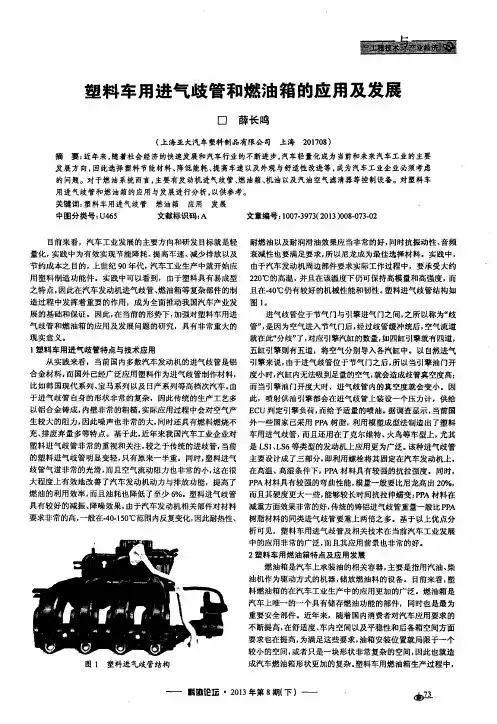
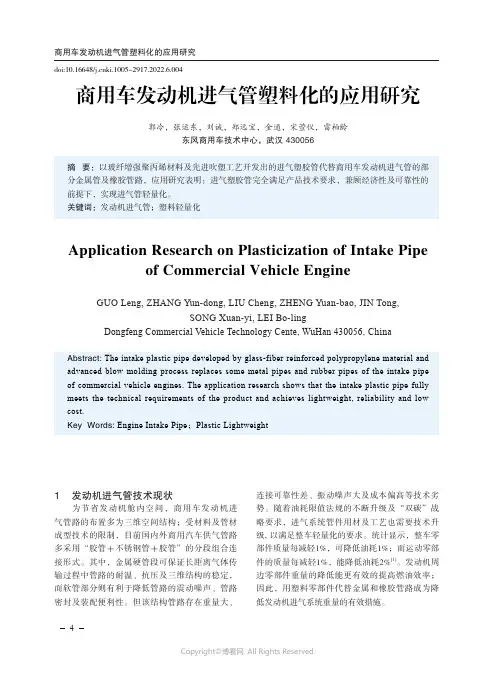
doi:10.16648/ki.1005-2917.2022.6.004商用车发动机进气管塑料化的应用研究郭冷,张运东,刘诚,郑远宝,金通,宋萱仪,雷柏龄东风商用车技术中心,武汉 430056摘 要:以玻纤增强聚丙烯材料及先进吹塑工艺开发出的进气塑胶管代替商用车发动机进气管的部分金属管及橡胶管路,应用研究表明:进气塑胶管完全满足产品技术要求,兼顾经济性及可靠性的前提下,实现进气管轻量化。
关键词:发动机进气管;塑料轻量化Application Research on Plasticization of Intake Pipe of Commercial Vehicle EngineGUO Leng, ZHANG Yun-dong, LIU Cheng, ZHENG Yuan-bao, JIN Tong,SONG Xuan-yi, LEI Bo-lingDongfeng Commercial Vehicle Technology Cente, WuHan 430056, ChinaAbstract: The intake plastic pipe developed by glass-fiber reinforced polypropylene material and advanced blow molding process replaces some metal pipes and rubber pipes of the intake pipe of commercial vehicle engines. The application research shows that the intake plastic pipe fully meets the technical requirements of the product and achieves lightweight, reliability and low cost.Key Words: Engine Intake Pipe;Plastic Lightweight1 发动机进气管技术现状为节省发动机舱内空间,商用车发动机进气管路的布置多为三维空间结构;受材料及管材成型技术的限制,目前国内外商用汽车供气管路多采用“胶管+不锈钢管+胶管”的分段组合连接形式。
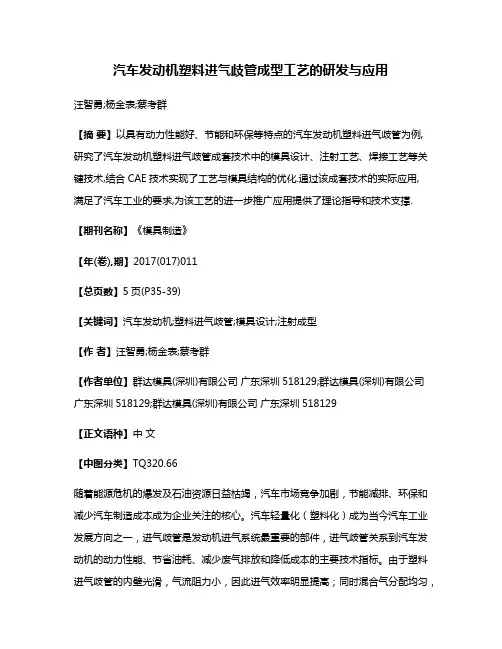
汽车发动机塑料进气歧管成型工艺的研发与应用汪智勇;杨金表;蔡考群【摘要】以具有动力性能好、节能和环保等特点的汽车发动机塑料进气歧管为例,研究了汽车发动机塑料进气歧管成套技术中的模具设计、注射工艺、焊接工艺等关键技术,结合CAE技术实现了工艺与模具结构的优化.通过该成套技术的实际应用,满足了汽车工业的要求,为该工艺的进一步推广应用提供了理论指导和技术支撑.【期刊名称】《模具制造》【年(卷),期】2017(017)011【总页数】5页(P35-39)【关键词】汽车发动机;塑料进气歧管;模具设计;注射成型【作者】汪智勇;杨金表;蔡考群【作者单位】群达模具(深圳)有限公司广东深圳518129;群达模具(深圳)有限公司广东深圳518129;群达模具(深圳)有限公司广东深圳518129【正文语种】中文【中图分类】TQ320.66随着能源危机的爆发及石油资源日益枯竭,汽车市场竞争加剧,节能减排、环保和减少汽车制造成本成为企业关注的核心。
汽车轻量化(塑料化)成为当今汽车工业发展方向之一,进气歧管是发动机进气系统最重要的部件,进气歧管关系到汽车发动机的动力性能、节省油耗、减少废气排放和降低成本的主要技术指标。
由于塑料进气歧管的内壁光滑,气流阻力小,因此进气效率明显提高;同时混合气分配均匀,排放也得到改善,发动机的动力性能明显改善;塑料制成的零部件不仅明显减轻了发动机的重量,而且具有金属零部件所无可比拟的优越性能。
塑料进气歧管与传统的铝合金进气歧管相比,具有质轻、设计自由度大、成本低,动力性能好、节能减排、环保等优点。
汽车发动机塑料进气歧管诞生于1972年,为当时的Porsche车进气歧管。
欧洲的汽车商率先采用尼龙制造进气歧管,随后美国、日本、韩国相继开发塑料进气歧管。
最早的塑料进气歧管选用了BASF公司的尼龙树脂,并采用熔芯成型法。
熔芯法生产的塑料进气歧管优点是歧管内部完整光滑,气体流动特性较好,最大限度地保证发动机的性能。

塑料进气歧管的发展与中国市场的调查The Development and Market of Plastic Air intake manifold in China汽车轻量化是汽车工业发展方向之一,也是一个汽车厂和国家技术进步和先进程度的重要标志。
为节能降耗、提高车速、改进外观和舒适性、降低成本,汽车厂越来越多地选用塑料替代金属。
塑料发动机进气歧管(plastic air intake manifold)是近年来开发成功的塑料部件范例,也是各国竞相开发的热门塑料汽车部件。
塑料进气歧管不仅质轻,而且由于内壁光滑,可改进气体流动性,提高气体流量,进气效率高,隔热效果好,因而能提高发动机性能和燃料利用率。
一塑料进气歧管(plastic air intake manifold)的优点如图:塑料进气歧管(plastic air intake manifold)具体而言,塑料进气歧管主要具有4方面的优点:(1)在重量方面,由于塑料进气歧管一般采用尼龙材料,其比重约为铝合金材料的50%。
(2)另外,塑料进气歧管的管壁厚度一般为2.5~3mm,而铝合金进气歧管的壁厚一般大于4mm。
因此,塑料进气歧管的重量相对要轻很多,通常仅为铝合金进气歧管的40%左右。
(3)在动力性方面,由于塑料进气歧管的内壁比较光滑,因此有利于提高进气充量。
与铝合金进气歧管相比,发动机的动力性可提高3%~5%。
(4)在经济性方面,塑料进气歧管能带来良好的气流,从而有助于汽油在发动机缸内的充分燃烧,使发动机的经济性和排放都能得到明显改善。
(5)在成本方面,虽然进气歧管所使用的塑料材料与铝合金材料的成本基本相同,但由于塑料进气歧管能够一次成型,成型后的合格率高,而铸造而成的铝合金进气歧管毛坯的成品率要低很多,且其机加工费用也相对较高,因此塑料进气歧管的生产成本通常比铝合金进气歧管低20%~35%。
二欧美塑料进气歧管的发展塑料进气歧管诞生于1972年,后来开发成功去芯成型法,进气歧管塑料化进程加快。
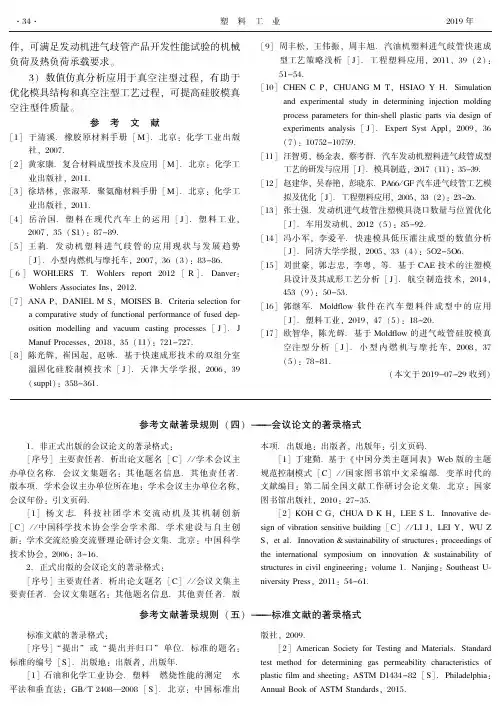
塑㊀料㊀工㊀业2019年㊀㊀件ꎬ可满足发动机进气歧管产品开发性能试验的机械负荷及热负荷承载要求ꎮ3)数值仿真分析应用于真空注型过程ꎬ有助于优化模具结构和真空注型工艺过程ꎬ可提高硅胶模真空注型件质量ꎮ参㊀考㊀文㊀献[1]于清溪.橡胶原材料手册[M].北京:化学工业出版社ꎬ2007.[2]黄家康.复合材料成型技术及应用[M].北京:化学工业出版社ꎬ2011.[3]徐培林ꎬ张淑琴.聚氨酯材料手册[M].北京:化学工业出版社ꎬ2011.[4]岳治国.塑料在现代汽车上的运用[J].塑料工业ꎬ2007ꎬ35(S1):87-89.[5]王莉.发动机塑料进气歧管的应用现状与发展趋势[J].小型内燃机与摩托车ꎬ2007ꎬ36(3):83-86. [6]WOHLERST.Wohlersreport2012[R].Danver:WohlersAssociatesInsꎬ2012.[7]ANAPꎬDANIELMSꎬMOISESB.Criteriaselectionforacomparativestudyoffunctionalperformanceoffuseddep ̄ositionmodellingandvacuumcastingprocesses[J].JManufProcessesꎬ2018ꎬ35(11):721-727. [8]陈光辉ꎬ崔国起ꎬ赵咏.基于快速成形技术的双组分室温固化硅胶制模技术[J].天津大学学报ꎬ2006ꎬ39(suppl):358-361.[9]周丰松ꎬ王伟振ꎬ周丰旭.汽油机塑料进气歧管快速成型工艺策略浅析[J].工程塑料应用ꎬ2011ꎬ39(2):51-54.[10]CHENCPꎬCHUANGMTꎬHSIAOYH.Simulationandexperimentalstudyindetermininginjectionmoldingprocessparametersforthin ̄shellplasticpartsviadesignofexperimentsanalysis[J].ExpertSystApplꎬ2009ꎬ36(7):10752-10759.[11]汪智勇ꎬ杨金表ꎬ蔡考群.汽车发动机塑料进气歧管成型工艺的研发与应用[J].模具制造ꎬ2017(11):35-39. [12]赵建华ꎬ吴春艳ꎬ彭晓东.PA66/GF汽车进气歧管工艺模拟及优化[J].工程塑料应用ꎬ2005ꎬ33(2):23-26. [13]张士强.发动机进气歧管注塑模具浇口数量与位置优化[J].车用发动机ꎬ2012(5):85-92.[14]冯小军ꎬ李爱平.快速模具低压灌注成型的数值分析[J].同济大学学报ꎬ2005ꎬ33(4):5O2-5O6. [15]刘世豪ꎬ郭志忠ꎬ李粤ꎬ等.基于CAE技术的注塑模具设计及其成形工艺分析[J].航空制造技术ꎬ2014ꎬ453(9):50-53.[16]郭继军.Moldflow软件在汽车塑料件成型中的应用[J].塑料工业ꎬ2019ꎬ47(5):18-20.[17]欧智华ꎬ陈光辉.基于Moldflow的进气岐管硅胶模真空注型分析[J].小型内燃机与摩托车ꎬ2008ꎬ37(5):78-81.(本文于2019-07-29收到)㊀参考文献著录规则(四) 会议论文的著录格式㊀㊀1.非正式出版的会议论文的著录格式:[序号]主要责任者.析出论文题名[C]//学术会议主办单位名称.会议文集题名:其他题名信息.其他责任者.版本项.学术会议主办单位所在地:学术会议主办单位名称ꎬ会议年份:引文页码.[1]杨文志.科技社团学术交流动机及其机制创新[C]//中国科学技术协会学会学术部.学术建设与自主创新:学术交流经验交流暨理论研讨会文集.北京:中国科学技术协会ꎬ2006:3-16.2.正式出版的会议论文的著录格式:[序号]主要责任者.析出论文题名[C]//会议文集主要责任者.会议文集题名:其他题名信息.其他责任者.版本项.出版地:出版者ꎬ出版年:引文页码.[1]丁建勤.基于«中国分类主题词表»Web版的主题规范控制模式[C]//国家图书馆中文采编部.变革时代的文献编目:第二届全国文献工作研讨会论文集.北京:国家图书馆出版社ꎬ2010:27-35.[2]KOHCGꎬCHUADKHꎬLEESL.Innovativede ̄signofvibrationsensitivebuilding[C]//LIJꎬLEIYꎬWUZSꎬetal.Innovation&sustainabilityofstructures:proceedingsoftheinternationalsymposiumoninnovation&sustainabilityofstructuresincivilengineering:volume1.Nanjing:SoutheastU ̄niversityPressꎬ2011:54-61.参考文献著录规则(五) 标准文献的著录格式㊀㊀标准文献的著录格式:[序号] 提出 或 提出并归口 单位.标准的题名:标准的编号[S].出版地:出版者ꎬ出版年.[1]石油和化学工业协会.塑料㊀燃烧性能的测定㊀水平法和垂直法:GB/T2408 2008[S].北京:中国标准出版社ꎬ2009.[2]AmericanSocietyforTestingandMaterials.Standardtestmethodfordetermininggaspermeabilitycharacteristicsofplasticfilmandsheeting:ASTMD1434-82[S].Philadelphia:AnnualBookofASTMStandardsꎬ2015.43。
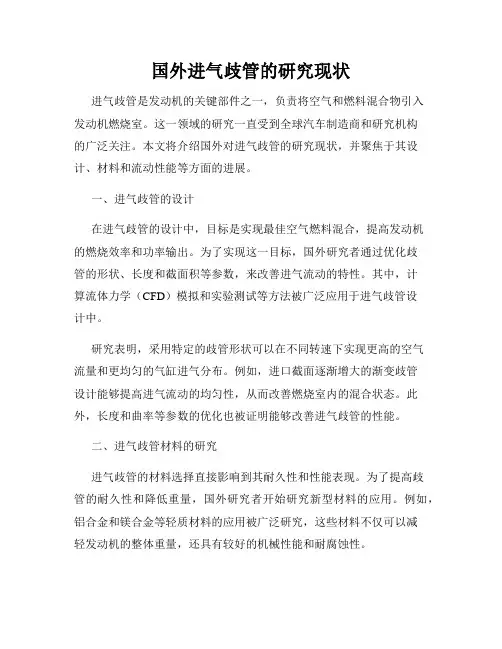
国外进气歧管的研究现状进气歧管是发动机的关键部件之一,负责将空气和燃料混合物引入发动机燃烧室。
这一领域的研究一直受到全球汽车制造商和研究机构的广泛关注。
本文将介绍国外对进气歧管的研究现状,并聚焦于其设计、材料和流动性能等方面的进展。
一、进气歧管的设计在进气歧管的设计中,目标是实现最佳空气燃料混合,提高发动机的燃烧效率和功率输出。
为了实现这一目标,国外研究者通过优化歧管的形状、长度和截面积等参数,来改善进气流动的特性。
其中,计算流体力学(CFD)模拟和实验测试等方法被广泛应用于进气歧管设计中。
研究表明,采用特定的歧管形状可以在不同转速下实现更高的空气流量和更均匀的气缸进气分布。
例如,进口截面逐渐增大的渐变歧管设计能够提高进气流动的均匀性,从而改善燃烧室内的混合状态。
此外,长度和曲率等参数的优化也被证明能够改善进气歧管的性能。
二、进气歧管材料的研究进气歧管的材料选择直接影响到其耐久性和性能表现。
为了提高歧管的耐久性和降低重量,国外研究者开始研究新型材料的应用。
例如,铝合金和镁合金等轻质材料的应用被广泛研究,这些材料不仅可以减轻发动机的整体重量,还具有较好的机械性能和耐腐蚀性。
此外,还有研究探索利用复合材料、陶瓷材料和纤维增强塑料等材料来制造进气歧管。
这些新材料具有高强度、高刚性和良好的耐腐蚀性,能够满足发动机高温和高压环境下的要求。
三、进气歧管的流动性能研究进气歧管的流动性能直接影响到发动机的燃烧效率和动力输出。
国外研究者通过实验测试和数值模拟等方法,研究了进气歧管中的流动特性,并进行了优化设计。
研究表明,降低进气系统的阻力和压力损失是提高发动机性能的关键。
为了降低阻力,一种常用的方法是通过在进气歧管内部设置流动控制装置,如壁面纹理、剪切层和定向流等。
这些措施能够改善进气流动的均匀性并减少压力损失。
此外,还有研究探索了利用进气歧管的分段设计和变流道技术来实现流量和压力的调节。
这些技术能够根据引擎负荷和工况要求,灵活调整进气歧管的几何形状和流道长度,以提供最佳的流动特性。
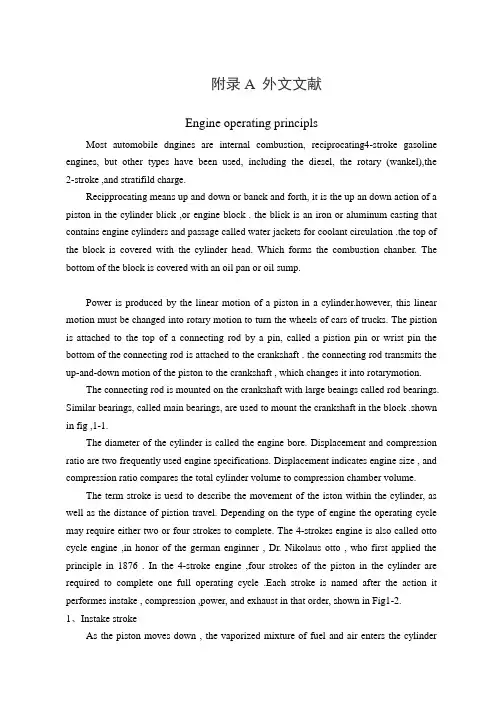
附录A 外文文献Engine operating principlsMost automobile dngines are internal combustion, reciprocating4-stroke gasoline engines, but other types have been used, including the diesel, the rotary (wankel),the 2-stroke ,and stratifild charge.Recipprocating means up and down or banck and forth, it is the up an down action of a piston in the cylinder blick ,or engine block . the blick is an iron or aluminum casting that contains engine cylinders and passage called water jackets for coolant circulation .the top of the block is covered with the cylinder head. Which forms the combustion chanber. The bottom of the block is covered with an oil pan or oil sump.Power is produced by the linear motion of a piston in a cylinder.however, this linear motion must be changed into rotary motion to turn the wheels of cars of trucks. The pistion is attached to the top of a connecting rod by a pin, called a pistion pin or wrist pin the bottom of the connecting rod is attached to the crankshaft . the connecting rod transmits the up-and-down motion of the piston to the crankshaft , which changes it into rotarymotion.The connecting rod is mounted on the crankshaft with large beaings called rod bearings. Similar bearings, called main bearings, are used to mount the crankshaft in the block .shown in fig ,1-1.The diameter of the cylinder is called the engine bore. Displacement and compression ratio are two frequently used engine specifications. Displacement indicates engine size , and compression ratio compares the total cylinder volume to compression chamber volume.The term stroke is uesd to describe the movement of the iston within the cylinder, as well as the distance of pistion travel. Depending on the type of engine the operating cycle may require either two or four strokes to complete. The 4-strokes engine is also called otto cycle engine ,in honor of the german enginner , Dr. Nikolaus otto , who first applied the principle in 1876 . In the 4-stroke engine ,four strokes of the piston in the cylinder are required to complete one full operating cycle .Each stroke is named after the action it performes instake , compression ,power, and exhaust in that order, shown in Fig1-2.1、Instake strokeAs the piston moves down , the vaporized mixture of fuel and air enters the cylinderthrough open instake vavle. To obtain the maximum filling of the cylinder the instake valve opens about 10° before t.b.c ,giving 20° overlap. The inlet valve remains open until some 50° after b.d.c to take advantage of incoming mixture.2、Compression strokeThe pieton turns up , the instake valve closes, the mixture is compressed within the combustion chamber, while the pressure rise to ahout 1 Mpa, depending on various factors inclouding the compression ratio, throttle opening and engine speed. Near the top of the stroke the mixture is ignited by a spark which bridge the gap of the spark plug.3、Power strokeThe expanding gases of combution produces a rise in pressure of the gas to some 3.5Mpa, and the piston is forced down in the cylinder. The exhaust valve opens near the bottom of the stroke.4、Exhust strokeThe piston moves back up with the exhause valve open some 50°before b.d.d.,allowing the pressure within the cylinder to fall and to reduce ‘back’ pressure on the piston during the exhaust stroke, and the burned gases are pushed out to prepare for the next instake stroke. The instake valve usually opens just before the exhaust stroke.This 4-stroke cycle is continuously repared in every as long as the engineremains runningA-2-stroke engine also goes through four actions to complete one operating cycle.However , the instake and the compression actions are combined in one seroke,and the power and exhaust actions are combined in the other stroke. The term2-stroke cycle or 2-stroke cycle or 2-stroke is preferred to the term 2-cycle, which is really not accurate.In automobile engines, all pistons are attached to a single crankshaft. The more cylinders an engine has ,the more power strokes produced for cach revolusion. This means that means that an 8-cylinder engine runs more smoothly because the power atrokes are closer together in time and in degrees of engine rotation.The cylinder of multi-cyclinder automotive engines arranged in one of three ways.1、Inline engine use a single block of cylinder. Most 4-cylinder and 6-cylinder engines areof this design. The cylinder do not have to be vertical. They can be inclined either side.2、V-type engine use two equal bands of cylinder , usually inclined 60degrees or 90degreesfrom the cach other. Most V-type engines have 6 or 8 cylinders, although V-4 and V-12engine have been built.3、Horizontally opposed or pancake engine have two equal banks of cylinders 180degreesapart . these space saving engine designs are often air-cooled,and are found in the chevrolet carvair porsches, Subaus,and V olkswagens. Subaus design is liquid ter –model V olkswagen vans use a liquil-cooled VWhorizontally opposed engine.附录B 中文翻译发动机工作原理大多数汽车的发动机是内燃机,往复四冲程汽油机,但是也有使用其他类型的发动机,包括柴油机,转子发动机二冲程发动机和分程燃烧发动机。
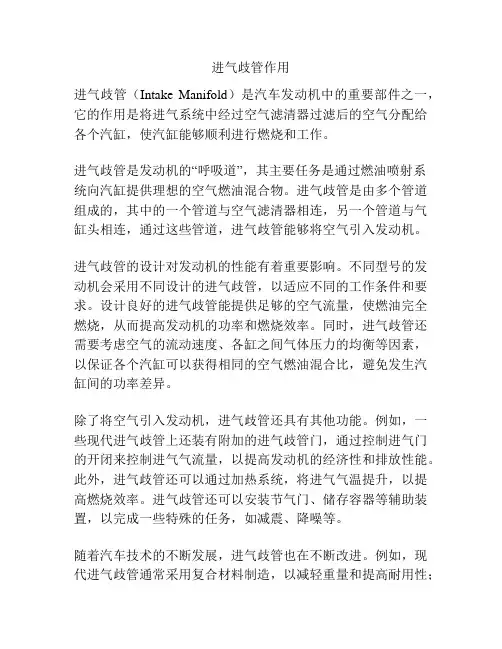
进气歧管作用进气歧管(Intake Manifold)是汽车发动机中的重要部件之一,它的作用是将进气系统中经过空气滤清器过滤后的空气分配给各个汽缸,使汽缸能够顺利进行燃烧和工作。
进气歧管是发动机的“呼吸道”,其主要任务是通过燃油喷射系统向汽缸提供理想的空气燃油混合物。
进气歧管是由多个管道组成的,其中的一个管道与空气滤清器相连,另一个管道与气缸头相连,通过这些管道,进气歧管能够将空气引入发动机。
进气歧管的设计对发动机的性能有着重要影响。
不同型号的发动机会采用不同设计的进气歧管,以适应不同的工作条件和要求。
设计良好的进气歧管能提供足够的空气流量,使燃油完全燃烧,从而提高发动机的功率和燃烧效率。
同时,进气歧管还需要考虑空气的流动速度、各缸之间气体压力的均衡等因素,以保证各个汽缸可以获得相同的空气燃油混合比,避免发生汽缸间的功率差异。
除了将空气引入发动机,进气歧管还具有其他功能。
例如,一些现代进气歧管上还装有附加的进气歧管门,通过控制进气门的开闭来控制进气气流量,以提高发动机的经济性和排放性能。
此外,进气歧管还可以通过加热系统,将进气气温提升,以提高燃烧效率。
进气歧管还可以安装节气门、储存容器等辅助装置,以完成一些特殊的任务,如减震、降噪等。
随着汽车技术的不断发展,进气歧管也在不断改进。
例如,现代进气歧管通常采用复合材料制造,以减轻重量和提高耐用性;一些高性能发动机会使用可变长度的进气歧管,以适应不同转速下的工作要求;一些先进的进气歧管还实现了进气气流的可变分配,以提高发动机的稳定性和动力输出。
总而言之,进气歧管是发动机中不可或缺的重要部件,它的作用是将经过滤清器过滤后的空气引入发动机,并分配给各个汽缸,以提供理想的燃油混合物。
进气歧管的设计对发动机的性能有着重要影响,它需要考虑空气流动速度、各汽缸之间的气体压力均衡等因素。
随着技术的不断进步,进气歧管的设计也在不断改进,以适应不同的工作要求和提高发动机的性能。
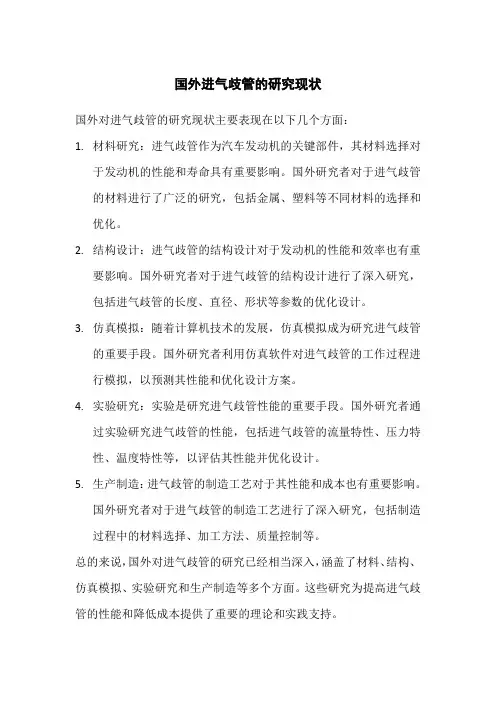
国外进气歧管的研究现状
国外对进气歧管的研究现状主要表现在以下几个方面:
1.材料研究:进气歧管作为汽车发动机的关键部件,其材料选择对
于发动机的性能和寿命具有重要影响。
国外研究者对于进气歧管的材料进行了广泛的研究,包括金属、塑料等不同材料的选择和优化。
2.结构设计:进气歧管的结构设计对于发动机的性能和效率也有重
要影响。
国外研究者对于进气歧管的结构设计进行了深入研究,包括进气歧管的长度、直径、形状等参数的优化设计。
3.仿真模拟:随着计算机技术的发展,仿真模拟成为研究进气歧管
的重要手段。
国外研究者利用仿真软件对进气歧管的工作过程进行模拟,以预测其性能和优化设计方案。
4.实验研究:实验是研究进气歧管性能的重要手段。
国外研究者通
过实验研究进气歧管的性能,包括进气歧管的流量特性、压力特性、温度特性等,以评估其性能并优化设计。
5.生产制造:进气歧管的制造工艺对于其性能和成本也有重要影响。
国外研究者对于进气歧管的制造工艺进行了深入研究,包括制造过程中的材料选择、加工方法、质量控制等。
总的来说,国外对进气歧管的研究已经相当深入,涵盖了材料、结构、仿真模拟、实验研究和生产制造等多个方面。
这些研究为提高进气歧管的性能和降低成本提供了重要的理论和实践支持。

汽车发动机外文文献翻译(含:英文原文及中文译文)文献出处:Talom M. AUTOMOTIVE ENGINE[J]. Applied Thermal Engineering, 2013, 2(3):39-45.英文原文AUTOMOTIVE ENGINETalom M1 Engine Classification and Overall MechanicsThe automobile engines can be classified according to: (1) cycles, (2) cooling system, (3) fuel system, (4) ignition method, (5) valve arrangement, (6) cylinder arrangement, (7) engine speed.Engines used in automobiles are the internal combustion heat engines. The burning of gasoline inside the engine produces high pressure in the engine combustion chamber. This high pressure force piston to move, the movement is carried by connecting rods to the engine crankshaft. The crankshaft is thus made to rotate: the rotary motion is carried through the power train to the car wheels so that they rotate and the car moves.The engine requires four basic systems to run (Fig. 2-1). Diesel engines require three of these systems. They are fuel system, ignition system (except diesel), lubricating system andcooling system. However, three other related systems are also necessary. These are the exhaust system, the emission-control system, and the starting system. Each performs a basic job in making the engine run.2 Engine Operating PrinciplesThe term “stroke” is used to desc ribe the movement of the piston within the cylinder. The movement of the piston from its uppermost position (TDC, top dead center) to its lowest position (BDC, bottom dead center) is called a stroke. The operating cycle may require either two or four strokes to complete. Most automobile engines operate on the four stroke cycle.In four-stroke engine, four strokes of the piston in the cylinder are required to complete one full operating cycle. Each stroke is named after the action. It performs intake, compression, power, and exhaust in that order.The intake strokeThe intake stroke begins with the piston near the top of its travel. As the piston begins its descent, the exhaust valve closes fully, the intake valve opens and the volume of the combustion chamber begins to increase, creating a vacuum. As the piston descends, an air/fuel mixture is drawn from the carburetor into the cylinder through the intake manifold. The intake stroke endswith the intake valve close just after the piston has begun its upstroke.Compression strokeAs the piston is moved up by the crankshaft from BDC, the intake valve closes. The air/fuel mixture is trapped in the cylinder above the piston. Future piston travel compresses the air/fuel mixture to approximately one-eighth of its original volume (approximately 8:1 compression ratio) when the piston has reached TDC. This completes the compression stroke. Power strokeAs the piston reaches TDC on the compression stroke, an electric spark is produced at the spark plug. The ignition system delivers a high-voltage surge of electricity to the spark plug to produce the spark. The spark ignites, or sets fire to, the air/fuel mixture. It now begins to burn very rapidly, and the cylinder pressure increases to as much as 3-5MPa or even more. This terrific push against the piston forces it downward, and a powerful impulse is transmitted through the connecting rod to the crankpin on the crankshaft. The crankshaft is rotated as the piston is pushed down by the pressure above it.Exhaust strokeAt the end of the power stroke the camshaft opens theexhaust valve, and the exhaust stroke begins. Remaining pressure in the cylinder, and upward movement of the piston, force the exhaust gases out of the cylinder. At the end of the exhaust stroke, the exhaust valve closes and the intake valve opens, repeating the entire cycle of events over and over again.3 Engine Block and Cylinder HeadEngine BlockThe engine block is the basic frame of the engine. All other engine parts either fit inside it or fasten to it. It holds the cylinders, water jackets and oil galleries (Fig. 2-4). The engine block also holds the crankshaft, which fastens to the bottom of the block. The camshaft also fits in the block, except on overhead-cam engines. In most cars, this block is made of gray iron, or an alloy (mixture) of gray iron and other metals, such as nickel or chromium. Engine blocks are castings.Some engine blocks, especially those in smaller cars, are made of cast aluminum. This metal is much lighter than iron. However, iron wears better than aluminum. Therefore, the cylinders in most aluminum engines are lined with iron or steel sleeves. These sleeves are called cylinder sleeves. Some engine blocks are made entirely of aluminum.Cylinder SleevesCylinder sleeves are used in engine blocks to provide a hard wearing material for pistons and piston rings. The block can be made of one kind of iron that is light and easy to cast while the sleeves uses another that is better able to stand up wear and tear.There are two main types of sleeves: dry and wet (Fig. 2-5).Dry sleeve Wet sleeveCylinder HeadThe cylinder head fastens to the top of the block, just as a roof fits over a house. The underside forms the combustion chamber with the top of the piston. In-line engine of light vehicles have just one cylinder head for all cylinders; larger in-line engines can have two or more. Just as with engine blocks, cylinder heads can be made of cast iron or aluminum alloy. The cylinder head carries the valves, valve springs and the rockers on the rocker shaft, this part of valve gear being worked by the pushrods. Sometimes the camshaft is fitted directly into the cylinder head and operates on the valves without rockers. This is called an overhead camshaft arrangement.GasketThe cylinder head is attached to the block with high-tensile steel studs. The joint between the block and the head must begas-tight so that none of the burning mixture can escape. This is achieved by using cylinder head gasket. Gaskets are also used to seal joins between the other parts, such as between the oil pan, manifolds, or water pump and the blocks.Oil PanThe oil pan is usually formed of pressed steel. The oil pan and the lower part of cylinder block together are called the crankcase; they enclose, or encase, the crankshaft. The oil pump in the lubricating system draws oil from the oil pan and sends it to all working parts in the engine. The oil drains off and run down into the pan. Thus, there is a constant circulation of oil between the pan and the working parts of the engine.4 Piston Assembly, piston rings, The piston pin ,Connecting Rods, Crankshafts And FlywheelPistonPiston rings and the piston pin are together called the piston assembly.The piston is an important part of a four-stroke cycle engine. Most pistons are made from cast aluminum. The piston, through the connecting rod, transfers to the crankshaft the force created by the burning fuel mixture. This force turns the crankshaft.To withstand the heat of the combustion chamber, the piston must be strong. It also must be light, since it travels at high speeds as it moves up and down inside the cylinder. The piston is hollow. It is thick at the top where it takes the brunt of the heat and the expansion force. It is thin at the bottom, where there is less heat. The top part of the piston is the head, or crown. The thin part is the skirt. Most pistons have three ring grooves at the top. The sections between the ring grooves are called ring lands.piston ringsPiston rings fit into ring grooves near the top of the piston. In simplest terms, piston rings are thin, circular pieces of metal that fit into grooves in the tops of the pistons. In modern engines, each piston has three rings. (Piston in older engines sometimes had four rings, or even five.) The inside surface of the ring fits in the groove on the piston. The ring's outside surface presses against the cylinder walls. Rings provide the needed seal between the piston and the cylinder walls. That is, only the rings contact the cylinder walls. The top two rings are to keep the gases in the cylinder and are called compression rings. The lower one prevents the oil splashed onto the cylinder bore fro m entering the combustion chamber, and is called an oil ring.The piston pinThe piston pin holds together the piston and the connecting rod. This pin fits into th e piston pin holes and into a hole in the top end of the connecting rod. The top end of t he rod is much smaller than the end that fits on the crankshaft. This small end fits inside the bottom of the piston. The piston pin fits through one side of the piston, through the small end of the rod, and then through the other side of the piston. It holds the rod firmly in place in the center of the piston. Pins are made of high-strength steel and have a hollow center. Many pins are chrome-plated to help them wear better. A piston pin fits into a round hole in the piston. The piston pin joins the piston to the connecting rod. The thick part of the piston that holds the piston pin is the pin boss. Connecting RodsThe connecting rod little end is connected to the piston pin.A bush made from a soft metal, such as bronze, is used for this joint. The lower end of the connecting rod f its the crankshaft journal. This is called the big end. For this big-end bearing, steel-backed lead or tin shell bearings are used. These are the same as those used for the main bearings. The split of the big end is sometimes at an angle, so that it is small enough t o be withdrawn through the cylinder bore. The connecting rod ismade from forged alloy steel.CrankshaftsThe crankshaft is regarded as the “backbone” of the engine (Fig. 2-7). The crankshaft, in conjunction with the connecting rod, converts the reciprocating motion of the piston to the rotary motion needed to drive the vehicle. It is usually made from car-bon steel which is alloyed with a small proportion of nickel. The main bearing journals fit into the cylinder block and the big end journals align with the connecting rods. At the rear end of the crankshaft is attached the flywheel, and at the front end are the driving wheels for the timing gears, fan, cooling water and alternator. The throw of the crankshaft, . the distance between the main journal and the big end centers, controls the length of the stroke. The stroke is double the throw, and the stroke length is the distance that the piston travels from TDC to BDC and vice versa.中文译文汽车发动机Talom M1发动机分类和一般力学(1)循环,(2)冷却系统,(3)燃料系统,(4)点火方法,(5)阀门布置,(6)气缸布置,(7)发动机速度。
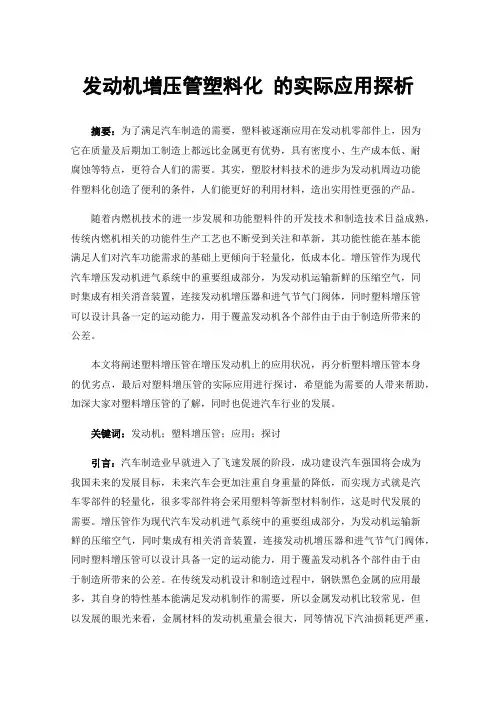
发动机增压管塑料化的实际应用探析摘要:为了满足汽车制造的需要,塑料被逐渐应用在发动机零部件上,因为它在质量及后期加工制造上都远比金属更有优势,具有密度小、生产成本低、耐腐蚀等特点,更符合人们的需要。
其实,塑胶材料技术的进步为发动机周边功能件塑料化创造了便利的条件,人们能更好的利用材料,造出实用性更强的产品。
随着内燃机技术的进一步发展和功能塑料件的开发技术和制造技术日益成熟,传统内燃机相关的功能件生产工艺也不断受到关注和革新,其功能性能在基本能满足人们对汽车功能需求的基础上更倾向于轻量化,低成本化。
增压管作为现代汽车增压发动机进气系统中的重要组成部分,为发动机运输新鲜的压缩空气,同时集成有相关消音装置,连接发动机增压器和进气节气门阀体,同时塑料增压管可以设计具备一定的运动能力,用于覆盖发动机各个部件由于由于制造所带来的公差。
本文将阐述塑料增压管在增压发动机上的应用状况,再分析塑料增压管本身的优劣点,最后对塑料增压管的实际应用进行探讨,希望能为需要的人带来帮助,加深大家对塑料增压管的了解,同时也促进汽车行业的发展。
关键词:发动机;塑料增压管;应用;探讨引言:汽车制造业早就进入了飞速发展的阶段,成功建设汽车强国将会成为我国未来的发展目标,未来汽车会更加注重自身重量的降低,而实现方式就是汽车零部件的轻量化,很多零部件将会采用塑料等新型材料制作,这是时代发展的需要。
增压管作为现代汽车发动机进气系统中的重要组成部分,为发动机运输新鲜的压缩空气,同时集成有相关消音装置,连接发动机增压器和进气节气门阀体,同时塑料增压管可以设计具备一定的运动能力,用于覆盖发动机各个部件由于由于制造所带来的公差。
在传统发动机设计和制造过程中,钢铁黑色金属的应用最多,其自身的特性基本能满足发动机制作的需要,所以金属发动机比较常见,但以发展的眼光来看,金属材料的发动机重量会很大,同等情况下汽油损耗更严重,这不符合当今节能环保的理念。
随着科学技术的进步和资源的紧缺、钢铁黑色金属价格的上涨、以及排放标准越来越严苛,我们必须要寻找新的出路,在符合发动机设计标准的前提下,开始寻找一些新型材料来替代金属材料,缓解汽车行业制作发动机方面的压力。
国外进气歧管的研究现状近年来,随着汽车工业的不断发展,进气歧管的研究也越来越受到关注。
国外许多研究机构和汽车制造商都在不断探索新的进气歧管设计和优化方法,以提高汽车的性能和燃油效率。
本文将介绍国外进气歧管研究的现状,并探讨其在汽车工业中的应用。
国外进气歧管的研究主要集中在以下几个方面:气流动力学分析、材料选择、减少进气阻力和提高燃烧效率。
首先,气流动力学分析是进气歧管研究的重要组成部分。
研究人员使用计算流体力学(CFD)等工具,通过模拟和分析气流在进气歧管中的流动情况,以优化进气歧管的设计。
通过优化歧管的几何形状和内部结构,可以改善气流的流动性能,减少阻力,提高燃烧效率。
研究人员还使用流动可视化技术,如激光测量和高速摄像等,来观察和分析气流的运动规律,以进一步改进进气歧管的设计。
其次,材料选择也是进气歧管研究的重要方面之一。
研究人员致力于寻找新型材料,以提高进气歧管的耐热性、耐腐蚀性和机械强度。
一些先进的复合材料和陶瓷材料已经应用于进气歧管的制造中,以满足高温高压的要求。
此外,一些研究还探讨了利用纳米材料改善进气歧管的性能,如利用纳米颗粒增强材料的热导率和强度。
减少进气阻力也是进气歧管研究的重要目标之一。
进气阻力直接影响到汽车的动力性能和燃油效率。
研究人员通过改进进气歧管的几何形状和内部结构,减少进气道的弯曲和阻力,以提高气流的进气效率。
此外,研究人员还利用流场优化等方法,通过优化进气歧管的内部流道结构,减少湍流和涡流的产生,以降低进气阻力。
最后,提高燃烧效率也是进气歧管研究的关键方面之一。
研究人员通过优化进气歧管的设计和燃烧室的配合,改善燃烧过程中的燃气混合和燃烧效果,以提高发动机的热效率和功率输出。
研究人员还研究了利用喷油系统和点火系统的新技术,如直接喷射和电火花点火,来进一步提高燃烧效率。
综上所述,国外进气歧管的研究现状主要包括气流动力学分析、材料选择、减少进气阻力和提高燃烧效率。
这些研究对于提高汽车性能和燃油效率具有重要意义。
2024年发动机排气歧管市场发展现状概述发动机排气歧管是内燃机的一个重要组成部分,主要用于将废气从汽缸排出,使之顺利流入排气系统。
随着汽车工业的快速发展,发动机排气歧管市场也呈现出不断扩大和创新的趋势。
本文将对发动机排气歧管市场的现状进行分析和讨论。
市场规模发动机排气歧管市场在过去几年中持续增长,并有望在未来几年保持强劲的增长态势。
据市场研究机构的数据显示,截至2020年,全球发动机排气歧管市场规模已经达到XX亿美元,并预计在未来五年内以X%的复合年增长率增长。
这一增长主要受到汽车销量增长和技术创新推动的影响。
市场驱动因素1. 汽车产量增长随着全球汽车市场的不断扩大,汽车产量也持续增长。
发动机排气歧管是每辆汽车都必要的部件之一,因此汽车产量的增长直接推动了发动机排气歧管市场的扩大。
2. 环保要求的提高全球环境保护意识的增强推动了汽车排放要求的提高。
发动机排气歧管作为排放控制的重要组成部分,在减少尾气排放方面起到了关键作用。
因此,环保要求的提高也促使了发动机排气歧管市场的发展。
3. 技术创新随着科技的不断进步,发动机排气歧管的设计和制造技术也在不断创新。
例如,轻量化材料的应用和优化的流体动力学设计,可以提高发动机排气歧管的效率和性能。
技术创新不仅推动了发动机排气歧管市场的发展,还提供了更多的发展机会。
市场竞争格局发动机排气歧管市场竞争激烈,存在多家主要供应商。
最大的竞争因素是价格、品质和交货能力。
市场上的几家领先厂商通过持续的技术创新和产品性能的提升,赢得了客户的信任和认可。
此外,合作与战略联盟也在市场竞争中发挥着重要作用。
发展趋势1. 轻量化设计轻量化是当前发动机排气歧管设计的重要发展趋势之一。
采用轻量化材料,如铝合金和复合材料,可以减轻发动机负荷,提升燃油效率并减少尾气排放。
2. 效率提升随着技术的不断进步,发动机排气歧管的设计和流体动力学性能得到了显著提升。
通过减少气流阻力和优化歧管的几何形状,可以提高发动机的热效率和动力输出。
曼胡默尔塑料进气歧管让发动机告别过热
佚名
【期刊名称】《现代零部件》
【年(卷),期】2009()10
【摘要】随着奥迪V8-TDI的推出,进气歧管不得不满足更苛刻的温度要求。
尤其随着涡轮增压技术、安装微粒滤清器以及提高废气再循环率逐渐成为发展趋势,导致进气系统中的温度越来越高。
单单为了满足更高的废气再循环率这一要求,进气歧管系统内的工作温度就需要达到200℃。
在微粒滤清器的再生阶段,温度可以保持200℃以上达数分钟。
【总页数】1页(P16-16)
【关键词】进气歧管;发动机;过热;塑料;温度要求;涡轮增压技术;进气系统;发展趋势【正文语种】中文
【中图分类】U464.134.4;U472.43
【相关文献】
1.曼·胡默尔新型滤声器有效节省进气系统空间 [J],
2.帝斯曼集团助力新型塑料进气歧管 [J], ;
3.曼胡默尔推出新型滤声器有效节省进气系统的空间 [J],
4.曼胡默尔塑料进气歧管让发动机告别过热 [J],
5.曼·胡默尔开发出塑料进气歧管升级产品 [J],
因版权原因,仅展示原文概要,查看原文内容请购买。
附录Engine plastic intake manifold application anddevelopment trendBecause plastic products unique advantages, plastic intake manifold will become aluminium alloy intake manifold alternative products.Since always, as the key components, domestic engine intake manifold are using aluminum alloy products. And according to understand, foreign plastic intake manifold application in a wide range, such as BMW, modern, nissan, which upscale automobile use plastic intake manifold.According to the auto air-intake system manufacturing company a technology expert introduction, compared with traditional aluminum alloy intake manifold, plastic intake manifold weighs just for aluminum manifold 1/2, its at low speed, low load power, torque increase was can reach above 10%. Meanwhile, the airway smooth plastic intake maifold, improve the engine performance, compared with aluminium alloy manifold fuel can reduce 6% to 8%, in addition, still can improve engine performance and emission function, reduce engine noise, and with the aluminum alloy intake manifold interchangeability strong.Domestic to automotive plastics intake manifold research startting evening, plastic intake manifold manufacturing and r&d technology is still in the blank, in this field technical level is low, its market share is less than 2%. Some of the country's auto manufacturers have to import from abroad plastic intake manifold high. "A technology expert says.Changan group technology development center of a personage thinks, along with the market competition, reduce automobile manufacturing costs into the central focus of automobile enterprise, new materials, new technology products are more valued and cheap plastic intake manifold replace traditional heavy metal intake manifold become an inevitable trend. Meanwhile, plastic intake manifold demand, will accompany the increases productioncar increases, its market prospect synchronization is nottaken lightly.In recent years, functional plastic application in automobile engine has made breakthrough progress, more and more engine components to begin using a plastic material production, especially with plastic intake manifold replace metal intake manifold has become an inevitable trend of automobile engine.With the traditional metal intake manifold, plastic intake manifold compared with what strengths?Metal intake manifold generally USES is cast iron or alloy material. In order to satisfy the engine intake and efi system installation requirements, and in manufacturing complex metal intake manifold often faced manufacturing difficulties, its yield is very difficult to guarantee.In 1990, the German BMW company USES molten core method successfully produce plastic intake manifold.Later, plastic intake manifold with its light weight, low cost, performance is good wait for a characteristic quickly replaced the goldBelong to intake manifold, become the new engine of choice. In European and American countries, about 90% of the exhaust from the opposite side of naturally aspirated engines use plastic intake manifold. Specifically, the plastic intake manifold main With four advantages:(1) in weight, because plastic intake manifold generally USES the nylon PA66 material, the proportion is about 50% of aluminum alloy material.(2) in addition, the thickness of the plastic intake manifold for 2.5 ~ 3mm commonly, and aluminum alloy intake manifold wall thickness generally greater than 4mm. Therefore, plastic intake manifold weight relative to light many, usually only for aluminum alloy around 40% of the intake manifold.(3) in power, because plastic intake manifold wall smoother, therefore to improve air filling quantity. Compared with aluminium alloy the intake manifold, engine performance can improve the 3% ~ 5%.(4) in the economic aspect, plastic intake manifold brings good airflow, thus helping to gasoline engine cylinder in full within the engine burn, the fuel consumption and emissions could have been improved obviously.(5) in cost, although the intake manifold of plastic materials used with aluminum alloy material cost basic same, but because plastic intake manifold can once moldings, forming the rate of high, while the aluminum alloy casting and into the yield of inlet manifold blank much lower, and the machining cost is relatively high, therefore plastic intake manifold production usually cost more than aluminum alloy intake manifold low 20% ~ 35%.At present, the plastic intake manifold preferred materials are nylon. Nylon is the advantage of high temperature resistant, chemical stability, but its shortcoming is larger, the percentage of ethylene glycol resistance performance also not too good, and its water is too strong, bibulous the strength will decline after nylon nearly 40%. Therefore, the widely-spreading use increased 25% ~ 35% of PA6 or PA66 fiberglass reinforced polyamide. Nylon before joining fiberglass, its shrinkage after obviously improved. For internal including cooling channel intake manifold, suggest using special anti glycol nylon formula.Although the world many plastic material supplier in continuously develops new intake manifold plastic materials, plastic materials in order to enhance the various performance, but nylon material is still the best choice at present.Plastic intake manifold production processCurrently the world what are the main types of plastic intake manifold production technology? What are the strengths and weaknesses of each?At present more mature plastic intake manifold processing technology is mainly molten core injection molding technology and vibration friction welding technology. The two technologies have different features.(1) molten core injection technology is the earliest, the most mature used plastic intake manifold production process. Its principle is: use the low melting point of solder alloy intake manifold inner cavity, and then the core nuclear assembly into a mold, again to mold to infuse nylon. Injection molding process is completed, a by nylon molding the shapes of the intake manifold in upcoming lumen core nuclear claddings inside. At this time, with internal metal core nuclear inlet manifold into melting in the pool, to make metal core nuclear melting. Because of the metal core nuclear melting point lower (generally), and nylon 110 ℃the melting point of relatively high, so in internal core in the process of nuclear melting plastic intake manifoldShape remain unchanged.Molten core method produce plastic intake manifold advantage is: intake manifold wall complete smooth, thereby improving the gas liquidity, can maximize the engine performance; Because be once the intake manifold injection molding, good air-tightness, high-yield; Molten core process can eliminate plastic intake manifold in injection molding process produces the residual stress, making intake manifold has better mechanical properties.Molten core method shortcoming is: in the metal core nuclear fusion molten core and core process, to consume large amounts of energy, thus make molten core method the cost of producing plastic intake manifold are relatively high.(2) vibration friction welding technology is also called "more pieces of welding method". When the intake manifold in design plastic complex structure, can be in the intake manifold due to relatively simple, can a structure of the injection molding, then two or more pieces of each piece by friction welder welding up, to form a complete plastic intake manifold.At present, most plastic intake manifold manufacturers are using vibration friction welding technology. Its main advantage is: high production efficiency, low cost. Its defect is the weld seams low intensity, appearance is bad, gas liquidity are relatively poor.Plastic intake manifold domestic production statusPlastic intake manifold of the nationalization process can be roughly divided into three stages:The first stage for imported stage. In the early 1990s, as some of the establishment of joint venture automobile enterprises, foreign advanced product line with the engine was introduced some introduction of domestic cars. In this one phase, plastic intake manifold as engine, its core of important component technology from foreign party control, imports cost is high.The second phase is mainly for some enterprises directly in domestic production. At this stage, the foreign-capital enterprise in foreign plastic intake manifold production line and complete mould to the home, use of domestic and cheap labor, for in the domestic provide matching the webuton of plastic intake manifold, and plastic intake manifold design &development work still at abroad.The third stage, with the domestic automobile manufacturing technology advances, some domestic enterprise started plastic intake manifold research and development work.Plastic intake manifold is a kind of high-tech products, including many engine aspects of key technology. But at present domestic most plastic intake manifold production enterprise past just ordinary plastic products factory, most of them do not have design and production engine technical ability, it could only be modelled some have outdated plastic intake manifold, their technical level the good and bad are intermingled.Overall, the current domestic production of plastic intake manifold ubiquitous technology level is low, and can not meet the requirements engine.发动机塑料进气歧管的应用与发展趋势由于塑料产品特有的优点,塑料进气歧管将成为铝合金进气歧管的替代产品。